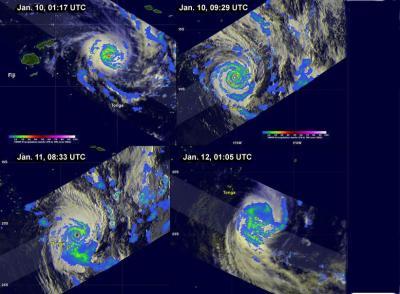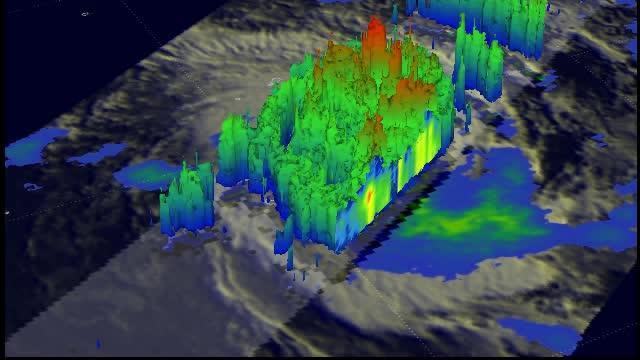NASA's TRMM satellite passed over Tropical Cyclone Ian three days in a row and captured rainfall and thunderstorm cloud height data about the deadly storm as it strengthened and weakened.
Tropical Cyclone Ian meandered in an area of the Pacific Ocean between Fiji and Tonga as it intensified from a tropical storm with winds of 35 knots/41 mph on January 5, 2014 to a deadly tropical cyclone with winds of 125 knots/144 mph on January 11, 2014. Tropical cyclone Ian caused extensive damage and an unknown number of deaths when it passed through Tonga at the peak of its intensity.
The Tropical Rainfall Measuring Mission or TRMM satellite provided excellent coverage of Ian with multiple passes directly above the tropical cyclone. Rainfall data collected by TRMM's Microwave Imager (TMI) and Precipitation Radar (PR) instruments with four passes. The first overpass on January 10, 2014 at 01:17 UTC showed Ian located between Fiji and Tonga when maximum sustained winds were estimated at 90 knots/104 mph. The second time TRMM passed over Ian was later in the day at 08:33 UTC/3:33 a.m. EST. Data from that overpass showed that Ian was much larger and better organized with a very well defined eye.
The next day, January 11, TRMM captured data on Ian when the tropical cyclone was passing close to the east of Tonga at 08:33 UTC/3:33 a.m. EST. Ian was then at its most dangerous category four intensity. TRMM data showed rain falling at the rate of over 169 mm/6.7 inches per hour around the nearly circular eye.
On January 12 at 01:05 UTC, TRMM showed a small area of heavy rainfall near Ian's center, with moderate to light rain throughout the rest of the system. By that time, Ian had moved to the southeast of Tonga.
TRMM's Precipitation Radar (PR) instrument collected data used to create a 3-D flyby animation Ian's well defined eye on January 11, 2014 at 0833 UTC/3:33 a.m. EST. Powerful thunderstorms in Ian's eye wall were found reaching heights of about 15 km/9.3 miles.
Ian dissipated in the South Pacific Ocean by January 13, 2014.

These 4 TRMM satellite images from Jan. 10-12 show the strengthening and weakening of Cyclone Ian. Red indicates heavy rainfall.
(Photo Credit: Image : SSAI/NASA, Hal Pierce)

TRMM's Precipitation Radar data was used to create this 3-D flyby animation Ian's well defined eye on January 11, 2014 at 0833 UTC/3:33 a.m. EST. Powerful thunderstorms in Ian's eye wall were found reaching heights of about 15 km/9.3 miles.
(Photo Credit: Image : SSAI/NASA, Hal Pierce)
Source: NASA/Goddard Space Flight Center